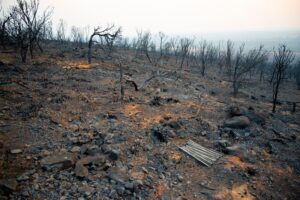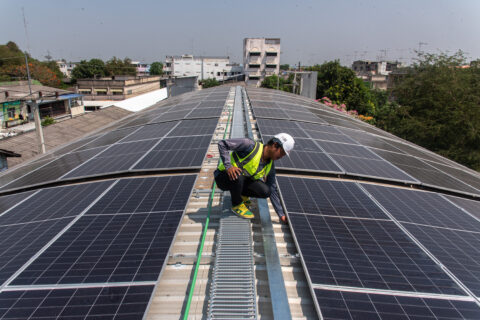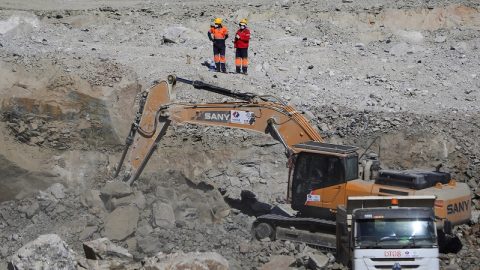More than a dozen wildfires have been sweeping through Los Angeles in California, consuming tens of thousands of acres of land and devastating some of the wealthiest neighbourhoods in the US.
As firefighters battle to contain the blazes, at least 24 people have died, while tens of thousands of people have been forced to evacuate and thousands of properties have been razed to the ground.
The disaster has received widespread attention across international media, covering the scale of the damage through to the causes of the fires – and the political spats they have triggered.
Both US president Joe Biden and his Californian vice-president Kamala Harris made the link between climate change and the fires.
Meanwhile, many scientists have pointed to “climate whiplash” – rapid switches from wet to dry conditions that are becoming more common in a warmer climate – as a factor in the scale of the devastation.
Many outlets have highlighted misleading claims by right-wing commentators about the Los Angeles fire department, as well as statements from incoming president Donald Trump casting blame on California’s Democratic governor, Gavin Newsom.
A number of outlets have also explored the impact of the wildfires – which have already been dubbed the costliest in US history – on the state’s already-fragile property insurance market.
In this article, Carbon Brief examines the role of climate change in the Los Angeles wildfires and how the media has covered the disaster.
- How did the wildfires develop around Los Angeles?
- How were the fires ignited?
- What have been the impacts of the fires?
- Does climate change have a role in driving the fires?
- What has been the political reaction?
- How has the media responded to the wildfires?
- What are the implications for insurance in the state?
How did the wildfires develop around Los Angeles?
Over the course of just a week in early January, multiple fires erupted in and around Los Angeles in southern California.
The first – and what became the largest – wildfire was the Palisades fire. This was first reported at around 10:30am on Tuesday 7 January and quickly spread, explained the Washington Post, “as winds gust[ed] to about 50 mph in the area”.
The Financial Times reported that more than 29,000 acres [11,174 hectares] were burned on Tuesday in Palisades, “an affluent coastal community with some of the most expensive property in the US”. With thousands of homes at risk, evacuation orders were issued for around 30,000 people, according to the newspaper.
Rescuers were “forced to use a bulldozer to clear a path” through gridlocked, abandoned cars for emergency services to pass, reported the Times.
Through the day, a “life-threatening” windstorm “accelerated the fire’s spread across a parched landscape that has had very little rain in months”, the FT said. This storm was the “strongest to hit southern California in more than a decade”, the Associated Press noted.
An AP photographer reported seeing “multi-million dollar mansions on fire as helicopters overhead dropped water loads”.
The Washington Post described the Palisades fire as a “monster from the start”, noting that it spanned “the size of 150 football fields within half an hour and an area larger than Manhattan a day after that”.
On Tuesday night, a fast-moving fire broke out in the hills above Altadena near Eaton Canyon, reported the Los Angeles Times, prompting further evacuation orders.
The Eaton fire had “quickly grown to 200 acres” [81 hectares] by Tuesday night, said the Times, while “another fire had ignited in Sylmar, a suburb north-west of Los Angeles, and had already consumed 50 acres [20 hectares] with some nearby residents ordered to evacuate”.
These three fires – Palisade, Eaton and what would later be named the Hurst fire – would become the focus of media coverage, but a number of other fires, such as Kenneth, Archer, Sunset, Lidia, Woodley and Olivas, also ignited across the region through the week.

By Tuesday evening, California governor Gavin Newsom had declared a state of emergency, CBS News reported.
On Wednesday, the wildfires “burned uncontrollably across a wide swathe of greater Los Angeles”, reported the Washington Post, “transforming the landscape into scenes of apocalyptic destruction with blocks and blocks of neighborhoods reduced to ash”.
By the end of the day, more than 1,000 structures had been destroyed, at least 130,000 people were under evacuation orders and nearly 1.5 million residents were without power, the newspaper said. The fires were still raging with “almost zero containment”, it added.
The newspaper quoted Los Angeles county fire chief Anthony Marrone, who warned that his department was prepared for one or two major fires, but not for “this type of widespread disaster”. He added:
“There are not enough firefighters in LA county to address…fires of this magnitude.”
In response, firefighting teams from across California and the west “poured into the Los Angeles region in recent days to help relieve and reinforce local crews”, said the Washington Post.
Reports also emerged that firefighters were, in the words of BBC News, “struggl[ing] with water supply to their hoses and hydrants”. Reuters noted that “Los Angeles authorities said their municipal water systems were working effectively but they were designed for an urban environment, not for tackling wildfires”.
In total, at least a dozen fires have raged across the greater Los Angeles area over the past week. By Friday, the two largest fires of Palisades and Eaton were 8% and 3% contained, respectively, reported the Los Angeles Times. This increased to 11% and 15% by Saturday morning.
[As of early Monday 13 January (Pacific Standard Time), fire containment stood at 14%, 33% and 95% for the Palisades, Eaton and Hurst fires, respectively, according to California’s Department of Forestry and Fire Protection. All other fires have been contained.]
With more heavy winds expected this week, a local fire chief told BBC News that the fight against the blazes is “at a fork in the road”, warning that the fires could “take off on Tuesday or Wednesday”.
How were the fires ignited?
Investigators are still exploring the initial cause of the fires, reported the Associated Press.
While lightning is the “most common source of fires in the US…investigators were able to rule that out quickly”, the newswire said. It explained:
“There were no reports of lightning in the Palisades area or the terrain around the Eaton fire.”
The next two most-common causes are “fires intentionally set and those sparked by utility lines”, it added.
NBC News reported that the key to identifying the cause of the Palisades fire lies “on a brush-covered hilltop where the blaze broke out just after 10:30am on Tuesday”. A former battalion chief for the Los Angeles Fire Department told the outlet that arson was an unlikely cause:
“This is what we call inaccessible, rugged terrain…Arsonists usually aren’t going to go 500 feet off a trailhead through trees and brush, set a fire and then run away.”
Analysis by the Washington Post suggested the cause was an extinguished fire from New Year’s Eve. Combining photos, videos, satellite imagery, radio communications and interviews, the newspaper concluded that “the new fire started in the vicinity of the old fire, raising the possibility that the New Year’s Eve fire was reignited, which can occur in windy conditions”.
The Daily Mail picked up the Washington Post’s reporting, describing it as a “haunting new theory”.
Other fires, such as the Eaton fire, were linked to power lines, reported NBC News (link above):
“Whipping winds can cause the lines to slap together, shedding small balls of superhot molten metal.”
The Guardian noted that “it is routine for utilities to shut off power during ‘red-flag events’, but the power lines were on near the Eaton and Palisades fires” when they started last week.
However, NBC News said, this was just one theory, adding that “it’s also possible that it was started by a person operating a camping stove or a car or lawn mower that ejected a hot spark onto dry grass”.
What have been the impacts of the fires?
The fires that swept through Los Angeles have consumed more than 40,000 acres [16,187 hectares] of land, spread across a number of neighbourhoods in both the city and Los Angeles county, according to an update from the Washington Post on Monday 13 January.
The outlet also noted the fires had claimed the lives of 24 individuals at the latest count.
NPR added that more than 12,000 structures, including houses and businesses, had been destroyed by the fires over seven days.
In a separate article, the Washington Post mapped the wildfires in various areas in Los Angeles – Palisades, Eaton and Hurst. It noted that, as of 12 January, the Lidia, Sunset, Woodley, Archer and Kenneth fires had been contained.
In response to the fires, evacuation orders were issued for approximately 153,000 people in LA county, NBC Los Angeles reported.

The New York Times added that some evacuees found temporary housing in Los Angeles hotels, including a luxury hotel in Santa Monica and 19 hotels owned by the IHG chain, which includes Intercontinental, Regent and Holiday Inn.
Evacuations were ordered in “many parts of Pacific Palisades, Malibu, Santa Monica, Calabasas, Brentwood and Encino”, Los Angeles Times reported. Meanwhile, in areas including Glenoaks Canyon and Chevy Chase Canyon, evacuation orders were lifted, allowing residents to return to their homes, according to the outlet.
However, due to poor air quality affecting regions not directly impacted by the fires, schools in Los Angeles were cancelled on Friday, according to NBC Los Angeles. “Nearly all LA unified [school district] campuses and all offices would reopen Monday”, the Los Angeles Times added.
Cultural events have also been impacted, with the nominations for the 97th Academy Awards, and the Critics’ Choice Awards being postponed, as well as television shows such as Grey’s Anatomy and Jimmy Kimmel Live!, as reported by ABC News.
Meanwhile, an early estimate of total damages by insurance provider AccuWeather, widely cited in the media, including BBC News, predicts the fires have caused $135-150bn in total damages.
The fires are expected to have a major impact on California’s property insurance market. (See: What are the implications for insurance in Los Angeles?)
Does climate change have a role in driving the fires?
The severity and likelihood of wildfires are affected by a wide range of conditions. Some of these are related to the climate, such as temperature, wind speed and rainfall. Meanwhile, others are linked to land use, such as the density and type of vegetation, or human-implemented fire-suppression techniques.
Nevertheless, there is a wide body of evidence showing that climate change is making wildfire conditions more likely in many parts of the world. Attribution studies have revealed that climate change has already made many individual wildfires more intense or likely. However, no such attribution study has yet been published about the Los Angeles wildfires.
News outlets and experts across the world have been making the climate connection to the fires in recent days. Many outlets note that Los Angeles has seen rapid swings between extremely dry and wet conditions over the past few years.
BBC News reported that “decades of drought in California were followed by extremely heavy rainfall for two years in 2022 and 2023”, which allowed lots of vegetation to grow. However, the state saw a switch to very dry conditions in the autumn and winter of 2024, which dried out the vegetation, providing ideal fuel for the wildfire.
The outlet highlighted a timely academic paper, which explains that climate change has increased “hydroclimate whiplash” conditions – the rapid swings between periods of high and low rainfall – globally by 31-66% since the middle of the 20th century.
Dr Daniel Swain – a climate scientist from UCLA, who led the research – wrote a Bluesky thread explaining why climate “whiplash” can create the ideal conditions for fires to spread. He said:
“In coastal southern California, where grass and brush (including chaparral) are predominant vegetation types, there is actually a historical relationship between wetter winters and increased fire activity in [the] following fire season.”
Many outlets unpacked the rapid changes in California’s rainfall. The Guardian reported that in both the rainy seasons of 2023 and 2024, more than 25 inches of rain fell over southern California. However, it said this year’s rainy season “is running at just 2% of normal for Los Angeles, which has only seen 0.16in [4mm] of rain so far”.
Al Jazeera reported that, on 7 January, only 39% of California was completely drought-free, with the rest of the state described as “abnormally dry”. However, around the same time last year, 97% of the state was classed as “drought-free”, with only 3% classed as abnormally dry, it said.
Many outlets also pointed to the Santa Ana winds. According to the Guardian, these winds blow dry, warm air into California from the US western desert during cooler months, and have contributed to many forest fires in the past. The Associated Press reported that the winds were “much faster than normal” this year and have been “whipping flames and embers at 100mph – much faster than normal”.
BBC News reported that the low-humidity Santa Ana wind “strips the vegetation of a lot of its moisture, meaning that fire can catch quicker and the vegetation burn more readily”.
Inside Climate News said the “unusually warm” band of the Pacific Ocean near southern California is bending the jet stream, allowing high pressure to settle over the north-east of Los Angeles, while intensifying the Santa Ana winds.
In the Conversation, Prof Jon Keelet from the University of California, Los Angeles, explained his research, which shows a shift in the timing of Santa Ana winds. “Due to well-documented trends in climate change, it is tempting to ascribe this to global warming, but, as yet, there is no substantial evidence of this,” he said.
What has been the political reaction?
As the fires blazed, US president Joe Biden met with California’s Democratic governor, Gavin Newsom, and approved his request for a major disaster declaration, enabling increased federal funding, according to the Los Angeles Times.
When asked by NBC News if he thought these fires would be the worst “natural” disaster in US history, Newsom replied: “I think it will be just in terms of just the costs associated.”
Craig Fugate, the Federal Emergency Management Agency (FEMA) administrator under former president Barack Obama, told the Los Angeles Times that the fires were LA’s “Hurricane Katrina” – a moment that would “forever change the community”.
Bloomberg reported that Biden said federal support would cover 100% of the costs of the fire response for 180 days. The president also directed 400 additional federal firefighters and more than 30 helicopters and planes towards the region, the news outlet added.
Both Biden and his Californian vice-president Kamala Harris made the link between climate change and the fires in their public statements.
The wildfires come at a fraught political moment for the US. Biden, who has championed climate action during his presidency, will soon be replaced by Donald Trump, a climate sceptic who has vowed to roll back many of his predecessor’s policies.
Trump’s response to the fires was summarised in an Associated Press headline that stated: “As wildfires rage in LA, Trump doesn’t offer much sympathy. He’s casting blame.”
The article said Trump had taken aim at his “longtime political foe” and falsely blamed Newsom’s forest management policies and fish conservation efforts in California for the water shortages affecting the response effort . It added that Trump “has a history of withholding or delaying federal aid to punish his political enemies”.
The Los Angeles Times noted that both Biden and current FEMA administrator Deanne Criswell “stopped short” of guaranteeing that aid would continue under Trump.
Following the incoming president’s remarks, Newsom addressed a letter to Trump inviting him to visit LA fire victims and stating “we must not politicise human tragedy or spread disinformation”, according to the Los Angeles Times.
There were also claims in right-wing media that Democratic LA mayor Karen Bass had cut the fire department’s budget, but the Los Angeles Times noted that its budget “actually grew by more than 7%”. BBC News and Media Matters both ran articles fact-checking various claims made about Democrats by figures on the US right.
The Guardian reported on “misinformation” spread by the US right, including claims that the LA fire department prioritised “diversity schemes” – often referred to as “DEI” – over fighting fires. Elon Musk, Trump’s new “efficiency tsar”, supported such claims, and wrote on Twitter: “Wild theory: maybe, just maybe, the root cause wasn’t climate change?”
Meanwhile, another Guardian article noted that “nearby blue and red states as well as foreign countries are making their own political statements in their decisions to deploy firefighters to aid California”. CBS Austin reported that Republican Texas governor, Greg Abbott, has provided resources to California.
Canada and Mexico sent firefighters to help in California, with Canadian prime minister Justin Trudeau offering his nation’s “full support”. Trump has threatened to impose punitive tariffs on both nations.
How has the media responded to the fires?
There has been extensive coverage in the media of the wildfires, across the US and around the world.
This has taken many forms, but there has been a particular focus in editorials on political divisions and the role of climate denial. For example, an editorial in the Guardian argued that “political obstruction is deepening a climate crisis that needs urgent action”.
In the Washington Post, columnist Jennifer Rubin said that the fires should affect the spread of climate denial, “but won’t”. She wrote:
“The hellish fires tearing through the Los Angeles area are a preview of what’s to come if politicians, ideologues and big oil continue to ignore climate change…These sorts of horror shows will become routine if climate change deniers, led by the [Make America Great Again] anti-science crowd, get their way.”
Explainers on the role of climate change in the Los Angeles wildfires have formed a notable part of the media reaction. This included pieces from the Associated Press, Al Jazeera, Channel 4 News, Le Monde, Axios and the Los Angeles Times, among others.
Elsewhere, right-leaning, climate-sceptic media has called into question the role of climate change and conservation on the wildfires. Many have also criticised the Democratic government of California, as well as the Los Angeles fire chief and members of her department.
In the Daily Telegraph, Freddy Gray, deputy editor of the Spectator, argued that “the LA fires are an epitaph for Democrat misrule”, hitting out at the “climate change lobby” and arguing that the Biden administration “spent far too much time and resources pursuing politically correct causes at the expense of competent or even sane governance”.
An article in the New York Post hit out at Los Angeles mayor Karen Bass’s “botched response” to the fires. It also amplified the comments made across social media by celebrities such as actor James Woods, who claimed that “the fire is not from ‘climate change’” and instead blamed “liberal idiots” for electing “liberal idiots like Gavin Newsom and Karen Bass”.
As noted in a piece in Forbes, Youtubers have been among the right-wing influencers pushing criticism of fire department policy. For example, journalist Megyn Kelly – recently dubbed the “Rumplestiltskin of irritation” in Vox – alleged that the fire chief “has made not filling the fire hydrants top priority, but diversity” in a viral clip.
Similar misleading claims have been made on social media, including by Twitter CEO and leader of the new US Department of Government Efficiency Elon Musk, who, as noted above, argued the Los Angeles fire department “prioritised [DEI] over saving lives and homes”.
In response to the misinformation and disinformation being spread, there has also been a wave of articles attempting to counter or factcheck claims. This includes articles in the Guardian, the Los Angeles Times, BBC News and the Times, among others.
One specific aspect of the coverage of the Los Angeles wildfires has been the impact on celebrities, with the homes of Billy Crystal, Paris Hilton and Eugene Levy destroyed in the fires. As such, there has been a range of coverage from sources for whom disasters would generally fall outside their remit, including Hello!, Elle, TMZ and others.
An editorial in the Daily Mirror argued that “the destruction of celebrity mansions has captured attention, but we should not forget ordinary Americans”.
What are the implications for insurance in Los Angeles?
Media coverage has highlighted how the fires are set to deliver a major blow to the area’s property insurance market – seen as in “crisis” already – with major consequences for the Californian economy and households across the state.
Insured losses of the Los Angeles fires are expected to be in the tens of billions, according to early predictions from the insurance industry cited by Bloomberg and Reinsurance News.
The eye-watering damages are driven in part by Los Angeles’ expensive real estate. The National Post said the wildfires could prove to be “the costliest in US history, specifically because they have ripped through densely populated areas with higher end-properties”. Properties in the affected Palisades neighbourhood, for example, have a median home value of $3.1m, according to real-estate data cited in a CBS News report.
After wildfires in 2017 and 2018 decimated the industry’s profits, insurers have pulled back from California’s property insurance market in recent years, making it difficult for homeowners to find affordable cover. State Farm, Allstate and Farmers Insurance are among the insurers that have either dropped California policies or halted underwriting in recent years, CBS News said.
As a result, the Los Angeles Times said the fires threaten “to deepen a crisis that has already left hundreds of thousands of Californians struggling to find and keep affordable homeowners insurance”.
Meanwhile, the New Yorker said the “insurance crisis” has been “years in the making”, noting that people had been moving to wildfire-prone areas, despite fires “becoming more destructive, in large measure due to climate change”.
The retreat of insurers from California means a significant proportion of homeowners in Los Angeles rely on the state’s insurer of last resort, California’s Fair Access to Insurance Requirements (FAIR) plan.
There are now concerns the FAIR plan – which is run by the state government, but pools funds from insurers – could run out of money, putting private insurance firms on the hook to foot the bill. These costs – which could be as large as $24bn, according to the San Francisco Chronicle – would likely be passed on to insurance policyholders across the state.
The New York Times said such a scenario “would further strain the financial health of those insurers, adding to the pressure to pull back from the [California property insurance] market”. It adds:
“The potential consequences are huge. Without insurance, banks won’t issue a mortgage; without a mortgage, most people can’t buy a home. Fewer buyers mean falling home prices, threatening the tax base of fire-prone communities. It’s a scenario that could come to define California, as rising temperatures and drier conditions caused by climate change intensify the risk of wildfires.”
The Los Angeles Times said rising insurance costs for homeowners were just one way the fires would exacerbate the region’s “housing affordability crisis”. The paper has also pointed to higher rents and fierce competition for contractors that can rebuild destroyed and damaged properties.
The crisis comes as insurers around the world grapple with the rising costs attached to escalating climate impacts. Munich Re data – covered by Reuters – reveals that extreme weather events in 2024 caused an estimated $140bn in insured losses globally, up from $106bn the previous year.
Dave Jones, the former insurance commissioner of California and director of the Climate Risk Initiative at Berkeley School of Law, told Time the dynamics hurting California’s beleaguered insurance market could spread to other states as climate impacts intensified. He said:
“In the long term, we’re not doing enough to deal with the underlying driver, which is fossil fuels and greenhouse gas emissions, so we’re going to continue to see insurance unavailability throughout the US. We are marching steadily towards an uninsurable future in this country.”
The post Media reaction: The 2025 Los Angeles wildfires and the role of climate change appeared first on Carbon Brief.
Media reaction: The 2025 Los Angeles wildfires and the role of climate change
Climate Change
Colombia proposes expert group to advance talks on minerals agreement
Colombia wants countries to discuss options for a global agreement to ensure that the extraction, processing and recycling of minerals – including those needed for the clean energy transition – don’t harm the environment and human wellbeing.
The mineral-rich nation is proposing to create an expert group to “identify options for international instruments, including global and legally-binding instruments, for coordinated global action on the environmentally sound management of minerals and metals through [their] full lifecyle”.
Colombia hopes this will eventually lead to an agreement on the need for an international treaty to define mandatory rules and standards that would make mineral value chains more transparent and accountable.
The proposal was set out in a draft resolution submitted to the UN Environment Assembly (UNEA) earlier this week and seen by Climate Home News. UNEA, which is constituted of all UN member states, is the world’s top decision-making body for matters relating to the environment. The assembly’s seventh session will meet in Kenya in December to vote on countries’ proposals.
Soaring demand for the minerals used to manufacture clean energy technologies and electric vehicles, as well as in the digital, construction and defence industries have led to growing environmental destruction, human rights violations and social conflict.
Colombia argues there is an “urgent need” to strengthen global cooperation and governance to reduce the risks to people and the planet.
Options for a global minerals agreement
The proposal is among a flurry of initiatives to strength global mineral governance at a time when booming demand is putting pressure on new mining projects.
Colombia, which produces emeralds, gold, platinum and silver for exports, first proposed the idea for a binding international agreement on minerals traceability and accountability on the sidelines of the UN biodiversity talks it hosted in October 2024.
Since then, the South American nation has been quietly trying to drum up support for the idea, especially among African and European nations.
Its draft resolution to UNEA7 contains very few details, leaving it open for countries to discuss what kind of global instrument would be best suited to make mineral supply chains more transparent and sustainable.
Does the world need a global treaty on energy transition minerals?
Colombia says it wants the expert group to build on other UN initiatives, including a UN Panel on Critical Energy Transition Minerals, which set out seven principles to ensure the mining, processing and recycling of energy transition minerals are done responsibly and benefit everyone.
The group would include technical experts and representatives from international and regional conventions, major country groupings as well as relevant stakeholders.
It would examine the feasibility and effectiveness of different options for a global agreement, consider their costs and identify measures to support countries to implement what is agreed.
The resolution also calls for one or two meetings for member states to discuss the idea before the UNEA8 session planned in late 2027, when countries would decide on a way forward.
No time to lose for treaty negotiations
Colombia’s efforts to advance global talks on mineral supply chains have been welcomed by resource experts and campaigners. But not everyone agrees on the best strategy to move the discussion forward at a time when multilateralism is coming under attack.
Johanna Sydow, a resource policy expert who heads the international environmental policy division of the Heinrich-Böll Foundation, said she had hoped that the resolution would explicitly call for negotiations to begin on an international minerals treaty.
“Treaty negotiations take a long time. If you don’t even start with it now, it will take even longer. I don’t see how in two or three years it will be easier to come to an agreement,” she told Climate Home.
Despite the geopolitical challenges, “we need joint rules to prevent a huge race to the bottom for [mineral] standards”. That could start with a group of countries coming together and starting to enforce joint standards for mining, processing and recycling minerals, she said.
But any meaningful global agreement on mineral supply chains would require backing from China, the world’s largest processor of minerals, which dominates most of the supply chains. And with Colombia heading for an election in May, it will need all the support it can get to move its proposal forward.
‘Voluntary initiative won’t cut it’
Juliana Peña Niño, Colombia country manager at the Natural Resource Governance Institute, is more optimistic. “Colombia’s leadership towards fairer mineral value chains is a welcome step,” she told Climate Home News.
“At UNEA7, we need an ambitious debate that gives the proposed expert group a clear mandate to advance concrete next steps — not delay decisions — and that puts the voices of those most affected at the centre. One thing is clear: the path forward must ultimately deliver a binding instrument, as yet another voluntary initiative simply won’t cut it,” she said.
More than 50 civil society groups spanning Latin America, Africa and Europe previously described Colombia’s work on the issue as “a chance to build a new global paradigm rooted in environmental integrity, human rights, Indigenous Peoples’ rights, justice and equity”.
“As the energy transition and digitalisation drive demand for minerals, we cannot afford to repeat old extractive models built on asymmetry – we must redefine them,” they wrote in a statement.
Main image: The UN Environment Assembly is hosted in Nairobi, Kenya. (Natalia Mroz/ UN Environment)
The post Colombia proposes expert group to advance talks on minerals agreement appeared first on Climate Home News.
Colombia proposes expert group to advance talks on minerals agreement
Climate Change
California Sanctions Stark Disparities in Pesticide Exposure During Pregnancy
If you’re young, pregnant and Latina, chances are you live near agricultural fields sprayed with higher levels of brain-damaging organophosphate pesticides.
A baby in the womb has few defenses against industrial petrochemicals designed to kill.
California Sanctions Stark Disparities in Pesticide Exposure During Pregnancy
Climate Change
DeBriefed 3 October 2025: UK political gap on climate widens; Fossil-fuelled Typhoon Ragasa; ‘Overshoot’ unknowns
Welcome to Carbon Brief’s DeBriefed.
An essential guide to the week’s key developments relating to climate change.
This week
Shattered climate consensus
FRACKING BAN: UK energy secretary Ed Miliband has announced that the government will bring forward its plans to permanently ban fracking, in a move designed to counter a promise from the hard-right Reform party to restart efforts to introduce the practice, the Guardian said. In the same speech, Miliband said Reform’s plans to scrap clean-energy projects would “betray” young people and future generations, the Press Association reported.
ACT AXE?: Meanwhile, Kemi Badenoch, leader of the Conservatives, pledged to scrap the 2008 Climate Change Act if elected, Bloomberg reported. It noted that the legislation was passed with cross-party support and strengthened by the Conservatives.
‘INSANE’: Badenoch faced a backlash from senior Tory figures, including ex-prime minister Theresa May, who called her pledge a “catastrophic mistake”, said the Financial Times. The newspaper added that the Conservatives were “trailing third in opinion polls”. A wide range of climate scientists also condemned the idea, describing it as “insane”, an “insult” and a “serious regression”.
Around the world
- CLIMATE CRACKDOWN: The US Department of Energy has told employees in the Office of Energy Efficiency and Renewable Energy to avoid using the term “climate change”, according to the Guardian.
- FOREST DELAY: Plans for Brazil’s COP30 flagship initiative, the tropical forests forever fund, are “suffer[ing] delays” as officials remain split on key details, Bloomberg said.
- COP MAY BE ‘SPLIT’: Australia could “split” the hosting of the COP31 climate summit in 2026 under a potential compromise with Turkey, reported the Guardian.
- DIVINE INTERVENTION: Pope Leo XIV has criticised those who minimise the “increasingly evident” impact of global warming in his first major climate speech, BBC News reported.
€44.5 billion
The cost of extreme weather and climate change in the EU in the last four years – two-and-a-half times higher than in the decade to 2019, according to a European Environment Agency report covered by the Financial Times.
Latest climate research
- Fossil-fuelled climate change caused around 36% of Typhoon Ragasa’s direct damage to homes and properties in southern China, according to a rapid impact attribution study | Imperial Grantham Institute – Climate Change and the Environment
- Some 86% of the global population are concerned about climate change, according to a survey of 280,000 people in 142 countries and regions | Climate Policy
- A global shift towards a “planetary health diet” could slash emissions and save tens of thousands of lives each day | EAT-Lancet Commission 2025 report
(For more, see Carbon Brief’s in-depth daily summaries of the top climate news stories on Monday, Tuesday, Wednesday, Thursday and Friday.)
Captured

Clean energy has met 100% of Great Britain’s electricity demand for a record 87 hours this year so far, according to new Carbon Brief analysis. This is up from just 2.5 hours in 2021 and 64.5 hours in all of 2024. The longest stretch of time where 100% of electricity demand was met by clean energy stands at 15 hours, from midnight on 25 May 2025 through to 3pm on 26 May, according to the analysis.
Spotlight
‘Overshoot’ unknowns
As the chances of limiting global warming to 1.5C dwindle, there is increasing focus on the prospects for “overshooting” the Paris Agreement target and then bringing temperatures back down by removing CO2 from the atmosphere.
At the first-ever Overshoot Conference in Laxenburg, Austria, Carbon Brief asks experts about the key unknowns around warming “overshoot”.
Sir Prof Jim Skea
Chair of the Intergovernmental Panel on Climate Change (IPCC) and emeritus professor at Imperial College London’s Centre for Environmental Policy
So there are huge knowledge gaps around overshoot and carbon dioxide removal (CDR). As it’s very clear from the themes of this conference, we don’t altogether understand how the Earth would react in taking CO2 out of the atmosphere.
We don’t understand the nature of the irreversibilities and we don’t understand the effectiveness of CDR techniques, which might themselves be influenced by the level of global warming, plus all the equity and sustainability issues surrounding using CDR techniques.
Prof Kristie Ebi
Professor at the University of Washington’s Center for Health and the Global Environment
There are all kinds of questions about adaptation and how to approach effective adaptation. At the moment, adaptation is primarily assuming a continual increase in global mean surface temperature. If there is going to be a peak – and of course, we don’t know what that peak is – then how do you start planning? Do you change your planning?
There are places, for instance when thinking about hard infrastructure, [where overshoot] may result in a change in your plan – because as you come down the backside, maybe the need would be less. For example, when building a bridge taller. And when implementing early warning systems, how do you take into account that there will be a peak and ultimately a decline? There is almost no work in that. I would say that’s one of the critical unknowns.
Dr James Fletcher
Former minister for public service, sustainable development, energy, science and technology for Saint Lucia and negotiator at COP21 in Paris.
The key unknown is where we’re going to land. At what point will we peak [temperatures] before we start going down and how long will we stay in that overshoot period? That is a scary thing. Yes, there will be overshoot, but at what point will that overshoot peak? Are we peaking at 1.6C, 1.7C, 2.1C?
All of these are scary scenarios for small island developing states – anything above 1.5C is scary. Every fraction of a degree matters to us. Where we peak is very important and how long we stay in this overshoot period is equally important. That’s when you start getting into very serious, irreversible impacts and tipping points.
Prof Oliver Geden
Senior fellow and head of the climate policy and politics research cluster at the German Institute for International and Security Affairs and vice-chair of IPCC Working Group III
[A key unknown] is whether countries are really willing to commit to net-negative trajectories. We are assuming, in science, global pathways going net-negative, with hardly any country saying they want to go there. So maybe it is just an academic thought experiment. So we don’t know yet if [overshoot] is even relevant. It is relevant in the sense that if we do, [the] 1.5C [target] stays on the table. But I think the next phase needs to be that countries – or the UNFCCC as a whole – needs to decide what they want to do.
Prof Lavanya Rajamani
Professor of international environmental law at the University of Oxford
I think there are several scientific unknowns, but I would like to focus on the governance unknowns with respect to overshoot. To me, a key governance unknown is the extent to which our current legal and regulatory architecture – across levels of governance, so domestic, regional and international – will actually be responsive to the needs of an overshoot world and the consequences of actually not having regulatory and governance architectures in place to address overshoot.
Watch, read, listen
FUTURE GAZING: The Financial Times examined a “future where China wins the green race”.
‘JUNK CREDITS’: Climate Home News reported on a “forest carbon megaproject” in Zimbabwe that has allegedly “generated millions of junk credits”.
‘SINK OR SWIM’: An extract from a new book on how the world needs to adapt to climate change, by Dr Susannah Fisher, featured in Backchannel.
Coming up
- 7 October: International Energy Agency (IEA) renewables 2025 report launch
- 8-10 October: World summit of Indigenous peoples and nature, Abu Dhabi, UAE
- 9-15 October: International Union for the Conservation of Nature (IUCN) 2025 congress, Abu Dhabi, UAE
Pick of the jobs
- UK government foreign, commonwealth and development office, senior climate policy adviser | Salary: CA$93,207. Location: Calgary, Canada
- Wellcome Trust, senior research manager, climate and health | Salary: £64,800. Location: London
- Bloomberg, product manager – climate, nature and sustainability regulations | Salary: Unknown. Location: London
DeBriefed is edited by Daisy Dunne. Please send any tips or feedback to debriefed@carbonbrief.org.
This is an online version of Carbon Brief’s weekly DeBriefed email newsletter. Subscribe for free here.
The post DeBriefed 3 October 2025: UK political gap on climate widens; Fossil-fuelled Typhoon Ragasa; ‘Overshoot’ unknowns appeared first on Carbon Brief.
-
Climate Change2 years ago
Spanish-language misinformation on renewable energy spreads online, report shows
-
Climate Change Videos2 years ago
The toxic gas flares fuelling Nigeria’s climate change – BBC News
-
Climate Change2 months ago
Guest post: Why China is still building new coal – and when it might stop
-

 Greenhouse Gases1 year ago
Greenhouse Gases1 year ago嘉宾来稿:满足中国增长的用电需求 光伏加储能“比新建煤电更实惠”
-

 Climate Change1 year ago
Climate Change1 year ago嘉宾来稿:满足中国增长的用电需求 光伏加储能“比新建煤电更实惠”
-
Greenhouse Gases2 months ago
Guest post: Why China is still building new coal – and when it might stop
-

 Carbon Footprint1 year ago
Carbon Footprint1 year agoUS SEC’s Climate Disclosure Rules Spur Renewed Interest in Carbon Credits
-
Renewable Energy3 months ago
US Grid Strain, Possible Allete Sale
















